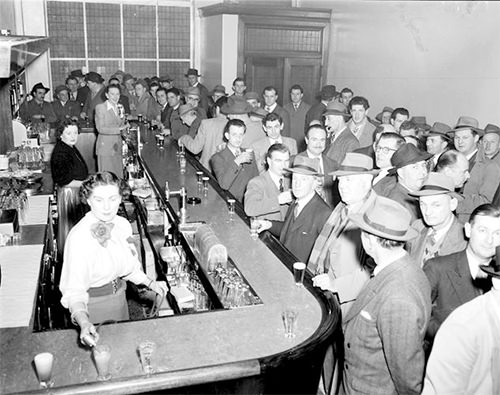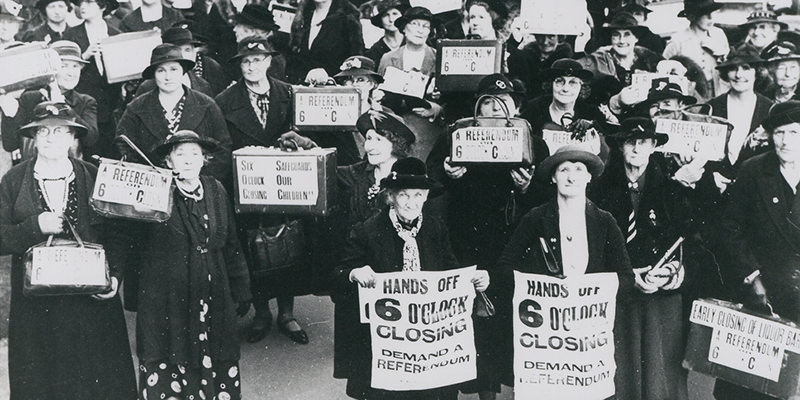We’ve heard at least one credible “Happy Hour” origin story. But Australia might be able to lay claim to its own. Maybe it’s no surprise, as this is the land of feisty individuality: vegemite, Paul Hogan, monster bunnies with built-in pockets that jump and punch and terrorize children.
Except the term “happy” wouldn’t quite apply here, since what emerged in Australia in the early to mid 20th Century was something closer to a decades’ long, government-enforced “last call,” where a rushed closing time encouraged equally rushed consumption of alcohol, and all the various indignities that accompany it. Barfing, punching, quite possibly a fight with a kangaroo. The phenomenon was ultimately dubbed the “six o’clock swill,” and while it might be relatively unknown in the States, it was a significant and slightly bizarre pivot point in the 20th Century history of Australian drinking culture.
Despite the name, the “six o’clock swill” really has no similarity to American happy hours, which tend to begin at 6pm and involve a bunch of coworkers playing verbal hot potato with who’s buying the first round. The six o’clock swill was actually the result of austerity measures taken during World War I (though more evidence of the “swill” phrase is found at the turn of WWII, according to Melbourne historian Tanja Luckins, with terminology prior along the lines of “speedy drinking” and even “six o’clock drinking rush”).
The core concept was limited consumption of alcohol as part of nationwide wartime efforts. In Australia, state-based Licensing Boards did their part by closing down a number of pubs and restricting the number of hours an establishment (a hotel bar or a pub) could stay open. But just like last call or the last desperate orders taken at happy hour, it didn’t all happen at once for Australia. Yes, South Australia was the first state to introduce early closing, in March of 1916, but Queensland didn’t introduce any early closing time at all, only going to 8 o’clock in 1923. But over the next decade or two, six o’clock, in most Australian states, became the standard for last call.

The outcome, as anyone rushing for a drink at the end of happy hour can understand, was less than temperate. Not even close. As Luckins notes, “One visiting journalist observed in 1936 that ‘men rushed’ from work to a bar were then ‘tossed drinks down at a gulp without time to taste them.’” Not that we’re quick to judge. If you’ve ever been stuck at your job as the clock ticked away the last minutes of happy hour, multiply that by about a thousand: people got out of work with some distance, only a few minutes, and hordes of other thirsty civilians literally standing between them and any hope of a drink. In case you doubt the desperation — or annoyance — factors at play, Luckins cites a 1935 poem written by a member of the New South Wales United Licensed Victuallers Association:
“Six o’clock, gentlemen, please!”
Oh, why can’t I drink at my ease?
When I finish working at five forty-five
I go for my life, so that I can arrive
And join all the rest in a desperate race,
To swallow my beer at a breath taking pace
But haunting my drink is the publican’s face –
And his “six o’clock, gentlemen, please!”
(The phrase “Six o’clock, gentlemen, please” is what barmen would say to alert the mass of customers that drinking time was, alas, over.)
That ticking clock became a kind of stopwatch for anyone hoping to get a buzz on in wartime Australia, and largely seemed to encourage orgiastic overconsumption. Not to suggest the country devolved into one huge bacchanalia for the quarter hour before closing time. Drinking efforts just became more aggressive and joylessly, almost maniacally efficient. Luckins notes one anonymous commenter, self-dubbed “Steady Drinker,” complained to the Sydney Morning Herald in 1935 that “the hours of ‘genial accord’ had been lost to the trend to ‘gulp down beer in the rush and hustle and slop of the closing hour.’” Luckins cites another writer, Perth essayist Walter Murdoch, who referred to men and women as ‘drunken beasts,’ with yet another admitting that “there was something pathetic to witness a ‘crowd howling for beer.’”
Despite the fairly obvious uptick in drinking habits—speed over experience, quantity over quality and all that—the early closing times remained on the books in most of Australia through WWII and beyond. By 1942, Prime Minister John Curtin actually had hotel bar operating hours cut down to six hours a day. (Women were also banned from pubs.) The motivation wasn’t entirely war-oriented pragmatism or even temperance specific to wartime; there was pressure from a wider temperance movement, active since the late 19th Century. With the emergence of WWI, temperance groups found a practical footing and justification for cutting back on nationwide consumption (ideally following that quietly up with just a dash of total prohibition).
Those dry dreams didn’t quite come true, nor did Australia devolve into a pit of hard-but-rapid-fire drinking. States began repealing the early closing hours in 1937, starting with Tasmania and legislation state to state going from there. Whatever hard drinking reputation Australia may have earned in the meantime, think about this: South Australia had adopted early closing hours in 1916. They only finally repealed them in 1967. And based on video evidence, everyone was pretty chill about it.

